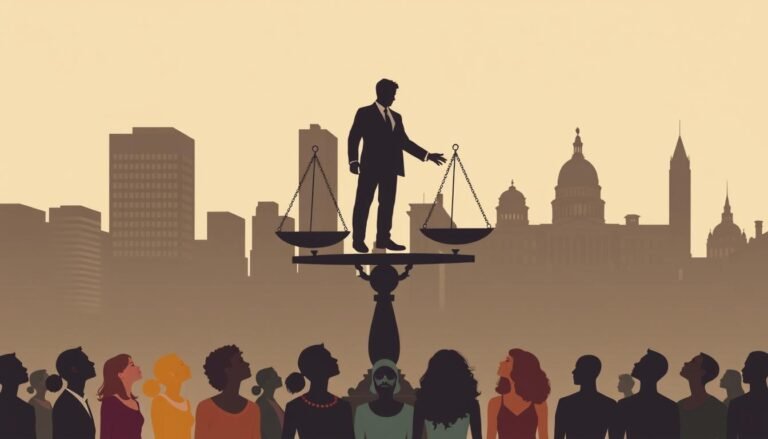Max Weber’s Theory of Bureaucracy Explained
Ever wonder why big organizations seem to run like clockwork? The answer might lie in Max Weber’s Theory of Bureaucracy. This groundbreaking concept has shaped how we think about management and organizational structure for over a century.
Weber, a German sociologist, introduced his theory of bureaucracy in the late 19th century. He saw it as the most efficient model for both private businesses and public offices. At its core, the theory emphasizes strict rules, clear power distribution, and rational authority.
Weber’s ideal bureaucracy aims for precision, speed, and clarity. It values knowledge, continuity, and strict subordination. The goal? To reduce friction and costs while boosting efficiency.
Today, many organizations still follow Weber’s principles. They shape everything from government agencies to large corporations. Understanding this theory can help us grasp why our workplaces function the way they do.
Key Takeaways
- Weber’s theory focuses on structured hierarchy and rules
- It aims to ensure efficiency and effectiveness in organizations
- The theory outlines six key characteristics of bureaucratic management
- Bureaucracies rely on policies, strict hierarchy, and regulated procedures
- While efficient, bureaucracies can face challenges like slow communication
Introduction to Max Weber and His Contributions
Max Weber, born in 1864, was a German sociologist who changed the fields of sociology, economics, and organizational theory. His work on rational legal authority and organizational structure changed how we manage and govern today.
Who was Max Weber?
Weber was a leading scholar of his time, working in sociology, economics, law, religion, and business. His visit to the United States in 1904 showed him the power of capitalism. This trip influenced his ideas on bureaucracy and management.
Weber’s impact on sociology and organizational theory
Weber changed how we think about social groups and power. He divided social status into economic class, status, and power. His famous work, “The Protestant Ethic and the Spirit of Capitalism,” looked at how religion affects the economy.
The context of Weber’s bureaucracy theory
Weber created his bureaucracy theory during a time of fast industrial growth and social change. He believed in the power of rational legal authority for modern organizations. His six key principles of bureaucracy include task specialization and clear rules for who gets ahead.
| Weber’s Contributions | Impact |
|---|---|
| Social Stratification Theory | Defined social differences through class, status, and power |
| Protestant Ethic Theory | Linked Protestant ethics to the development of modern capitalism |
| Bureaucracy Theory | Established principles for efficient organizational management |
| Social Action Theory | Emphasized understanding human actions through social context |
The Foundations of Weber’s Bureaucratic Theory
Max Weber, a German sociologist, laid the groundwork for modern organizational theory. He saw bureaucracy as a way to manage large groups efficiently. Weber believed in the power of structure, hierarchy, and rules to boost productivity.
Weber’s model is built on several important principles:
- Clear division of labor
- Hierarchical structure
- Formal rules and regulations
- Impersonal relationships
- Employment based on qualifications
- Career orientation
These principles aim to make organizations run smoothly and efficiently. Everyone knows their role and follows set procedures. Weber thought this would make organizations more productive and fair.
“A type of hierarchical organization designed rationally to coordinate the work of individuals in pursuit of large-scale administrative responsibilities.” – Max Weber’s definition of bureaucracy
Weber said that bureaucracies are full-time and long-lasting. Officials are chosen carefully and work under strict rules. This setup ensures stability and a focus on professionalism. Decisions are made fairly, not based on personal feelings.
Max Weber’s Theory of Bureaucracy Explained
Max Weber’s theory of bureaucracy is all about making organizations run smoothly and rationally. It helps shape how people work together in big places like companies and governments.
Weber’s Definition of Bureaucracy
Weber thought of bureaucracy as a set of rules and steps to make things run better. He wanted this system to stop favoritism and bring order to big groups.
Core Components of Ideal Bureaucracy
Weber said an ideal bureaucracy has six main parts:
- Clear division of labor
- Hierarchical management structure
- Formal selection rules
- Uniform requirements
- Impersonal environment
- Achievement-based advancement
These parts help make a system that values efficiency and fairness.
Rationalization in Bureaucratic Structures
Rationalization is key in Weber’s view. It means making decisions based on facts and logic, not feelings or who you know. This way, organizations can work better and be fairer.
“Bureaucracy constitutes the most efficient and rational way to organize human activity within institutions.” – Max Weber
Even though Weber’s ideas have some downsides, they still greatly influence how we organize work and divide tasks today.
The Six Principles of Bureaucracy
Max Weber, a key figure in bureaucracy theory, laid out six main principles. These principles are crucial for many big organizations today. They help shape how modern administrative systems work.
- Hierarchy of authority
- Division of labor
- Formal rules and regulations
- Impersonal relationships
- Career orientation
- Qualifications-based hiring
Weber’s ideas focus on making things run smoothly and efficiently. He believed in having clear lines of who’s in charge and dividing tasks to improve performance. Rules are set to keep things consistent, and dealing with people in a formal way helps keep things fair.
He also thought that having a career path would keep people committed. Hiring based on skills makes sure the team is well-equipped. These ideas still guide how organizations work, from governments to big companies and schools.
Even though some criticize bureaucracy today, its effects are still big. More than 90 countries are looking into these principles. This shows how important they are in managing complex organizations.
Hierarchical Structure in Bureaucratic Organizations
Max Weber’s theory highlights the need for a clear hierarchy of authority in organizations. This structure is key for making decisions efficiently and keeping communication clear.
Levels of Authority and Chain of Command
In bureaucratic setups, authority levels are well-defined. Each level has clear duties and answers to the one above it. This chain of command helps decisions move from top to bottom, keeping things in order and accountable.
Decision-Making Processes
The structure affects how decisions are made. Top managers make policies, and lower levels carry them out. This method helps operations run smoothly and keeps things consistent across the organization.
Advantages and Challenges
Hierarchical structures bring many benefits:
- Clear lines of authority
- Specialization of tasks
- Standardized procedures
But, they also have challenges:
- Slow decision-making
- Reduced flexibility
- Potential for communication breakdowns
Weber’s model, though seen as rigid, is still key to understanding how organizations work. Today’s businesses often tweak this model to balance efficiency with flexibility in a fast-changing world.
Division of Labor and Specialization
Max Weber’s theory shows how important division of labor is in organizations. It means breaking down big tasks into smaller, special roles. This makes organizations more efficient and productive.
In a bureaucratic setup, workers get specific jobs based on their skills. This way, they can use their strengths and get better at their jobs. Tasks get done quicker and better.
Division of labor also helps the whole organization. It makes the structure clear, defining what everyone does. This reduces confusion and makes work flow better.
| Aspect | Impact of Division of Labor |
|---|---|
| Efficiency | Increased through task specialization |
| Productivity | Enhanced due to focused expertise |
| Skill Development | Improved mastery in specific areas |
| Workflow | Streamlined with clear role definitions |
Division of labor has many benefits, but it also has downsides. Too much specialization can make work boring and reduce creativity. Companies need to find a balance. They should offer growth chances and encourage working together across different areas to keep things interesting.
Formal Rules and Standardized Procedures
In Weber’s theory, written rules and structure are crucial. They help large institutions run smoothly and efficiently.
The Importance of Written Regulations
Written rules guide all employees. They make sure everyone knows what they need to do. This leads to consistent work across the company.
Consistency and Predictability
Standardized procedures make things predictable. When steps are the same for everyone, results are more reliable. This is key for big organizations to work well.
A study found that 85% of bureaucratic groups use written rules and policies. This shows how important formal guidelines are for order and efficiency.
Challenges of Rigid Rule-Based Systems
Rules help keep things in order, but they can also cause issues. Being too rigid can make it hard to adapt to new situations. This can lead to:
- Slow decision-making processes
- Difficulty in handling unique cases
- Reduced creativity and innovation
Research says 70% of organizations struggle with change because of strict rules. This shows we need a balance between structure and flexibility in bureaucratic systems.
Impersonality and Objectivity in Bureaucracies
Bureaucracies rely on impersonality and objectivity. These traits help make decisions based on facts, not personal connections. In these systems, work relationships are strictly professional. This ensures fairness is the main focus.
Being impersonal is key in bureaucracies. It stops decisions from being swayed by favoritism or nepotism. Employees can then focus on their jobs without outside influences affecting their choices.
Objectivity in bureaucracies shows up in:
- Formal rules and procedures
- Merit-based hiring and promotion
- Standardized ways of making decisions
This approach helps ensure fairness. But, it can make it hard for staff to connect on a personal level. Finding a balance between objectivity and personal connections is a challenge.
Impersonality in these systems means decisions focus on the organization’s goals, not personal likes. This idea is key to Weber’s theory. It aims to give everyone an equal chance, no matter their background or who they know.
“In a bureaucracy, it’s not who you know, but what you know that matters.”
Bureaucracies aim to be fair and efficient by valuing impersonality and objectivity. This method, though sometimes seen as too strict, is vital for many modern organizations. It helps keep things fair and efficient.
Career Orientation and Merit-Based Advancement
In Weber’s theory, career orientation is key to the structure of organizations. It makes a work place where career officials can grow and succeed. This idea changes how bureaucracies work and how their staff feels.
The Concept of Lifelong Careers in Bureaucracies
Weber’s theory highlights the value of lifelong jobs for top performers. This focus on long careers makes the work environment stable. It lets employees get very good at what they do, helping both them and their companies.
Promotion Based on Qualifications and Performance
In bureaucracies, moving up is based on skills and how well you do your job. People get promoted for being good at what they do. This means the right people get important jobs, making the organization work better.
The Impact on Employee Motivation and Organizational Loyalty
The focus on careers in bureaucracies really helps motivate and keep employees loyal. By offering clear paths for moving up and rewarding hard work, companies can build a committed team. This approach makes employees want to improve their skills and help the company succeed over time.
Source Links
- Max Weber Bureaucracy Theory: Concept, Principles, and Forms
- Bureaucratic Management Theory of Max Weber
- Bureaucratic Theory of Management by Max Weber
- Max Weber’s Key Contributions to Sociology
- MAX WEBER’S THEORY OF BUREAUCRATIC MANAGEMENT
- Bureaucratic Theory by Max Weber – Explanation, Features, Rules and Laws
- Bureaucratic Theory by Max Weber : Structure, Function, and Criticisms – Political Science Solution
- Bureaucratic Management | Principles of Management
- Bureaucracy
- Father of Bureaucracy – Max Weber’s Theory & Principles of Bureaucracy
- Bureaucracy — Max Weber’s six characteristics of the bureaucratic form
- Bureaucracy | Definition, Characteristics, Examples, & Facts
- Bureaucratic Theory By Max Weber – Concept, Principles
- How to Use the Management Theory of Max Weber
- Bureaucracy – Six Principles Of Max Weber
- What is Bureaucracy Theory of Management? Complete Guide – MBANote
- What is Bureaucracy? – Understanding Bureaucracy – Definition, Types
- Max Weber’s Views on Bureaucracy
- Bureaucratic Management | Principles of Management







